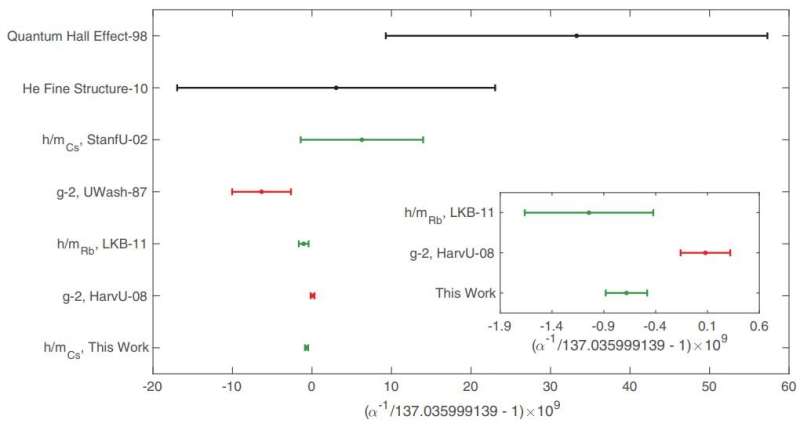April 13, 2018 report
Measurement of the fine-structure constant casts doubt on dark photon theories

A team of researchers from the University of California and Lawrence Berkeley National Laboratory has conducted an ultra-precise measurement of the fine-structure constant, and in so doing, have found evidence that casts doubts on dark photon theory. In their paper published in the journal Science, the group describes their measurement process and what they found by using it.
The fine-structure constant is a number that characterizes the strength of the force of electromagnetic interactions between charged particles, such as those that are involved in keeping electrons from traveling outside of their atoms. Up until now, it has been derived using the magnetic properties of electrons and calculations that are still considered to be theoretical. As the researchers note, more precise measurements allow for testing the Standard Model of particle physics. To that end, they sought to measure the constant through more direct means.
To accomplish this feat, they aimed a laser at cesium-133 atoms (matter-wave interferometry) to force them into quantum superposition and then took a close look at what happened between them as they relaxed back to their natural state. The interference that occurred, the team reports, revealed the speed at which the atoms traveled when they were struck by the laser—they used that number to determine the fine-structure constant. They claim their work has allowed for calculating the fine-structure constant to better than one part per billion.
The researchers report that the number they determined has closely matched the theory, which offers some confirmation of theories that suggest electrons are not made up of smaller, unknown particles. But it also casts doubt on theories surrounding the existence of dark photons.
Dark photons, theory has suggested, are particles nearly identical to photons, but have mass. They may also interact with other particles. If proof could be found of their existence, it would bolster theories regarding dark matter in general, because dark matter theory suggests they would be the force carrier. On the bright side, because the number they extracted was close to that theorized, but not exact, there is still room for other particle theories to explain the discrepancy.
More information: Richard H. Parker et al. Measurement of the fine-structure constant as a test of the Standard Model, Science (2018). DOI: 10.1126/science.aap7706
Abstract
Measurements of the fine-structure constant α require methods from across subfields and are thus powerful tests of the consistency of theory and experiment in physics. Using the recoil frequency of cesium-133 atoms in a matter-wave interferometer, we recorded the most accurate measurement of the fine-structure constant to date: α = 1/137.035999046(27) at 2.0 × 10−10 accuracy. Using multiphoton interactions (Bragg diffraction and Bloch oscillations), we demonstrate the largest phase (12 million radians) of any Ramsey-Bordé interferometer and control systematic effects at a level of 0.12 part per billion. Comparison with Penning trap measurements of the electron gyromagnetic anomaly ge − 2 via the Standard Model of particle physics is now limited by the uncertainty in ge − 2; a 2.5σ tension rejects dark photons as the reason for the unexplained part of the muon's magnetic moment at a 99% confidence level. Implications for dark-sector candidates and electron substructure may be a sign of physics beyond the Standard Model that warrants further investigation.
Journal information: Science
© 2018 Phys.org




















